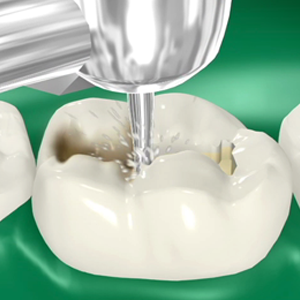
In the past, cavities could only be treated with unsightly metal fillings that are alloys for silver and mercury. These fillings, especially when close to the front of the mouth, are highly noticeable and unaesthetic. Sometimes, the filling is so large that it causes discoloration of the entire tooth. These fillings (or restorations) often weaken teeth due to the large amount of the original tooth that has to be removed. Also there is a risk of Mercury poisoning that is used in the filling. Modern dentistry has increasingly turned to Tooth colored or composite fillings as a strong, safe and more natural looking alternative. Composite fillings utilize a soft white plastic substance that is hardened with a blue light.
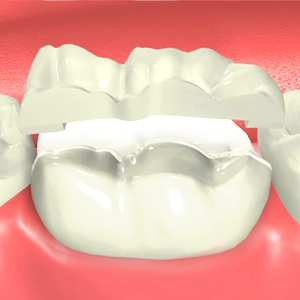
Replacing large fillings in back teeth often requires stronger, more precisely contoured restorations. These are called inlays or onlays depending on whether they are being placed inside the tooth or on its outer surface. These restorations need to be custom-made at an off-site dental lab; therefore, two visits may be required. Once the dental office receives the custom inlay or onlay, the patient returns to the dentist's office, where the restorations are bonded into place.
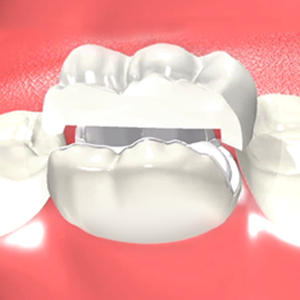
Onlays protect teeth similarly to crowns, but conserve more natural tooth structure. Onlays should provide decades of service. Our Doctor has restored beauty and function to the teeth of thousands of patients through the placement of custom-crafted inlays and onlays.
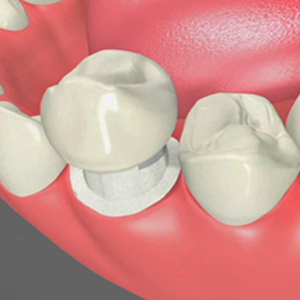
CROWNS: When a tooth is fractured, has a large old filling, or is severely damaged by decay, your dentist may recommend the placement of a crown. Crowns strengthen and protect the remaining tooth structure and can improve the appearance of your smile.
Types of crowns include the full porcelain crown, the porcelain-fused-to-metal crown (precious & non-precious) and the all-metal crown.
Fitting a crown requires at least two visits to the dentist's office. Initially, the Dentist removes decay and shapes the tooth; makes an impression and fits a temporary or transitional crown of plastic or metal. In a subsequent visit, the dentist removes the temporary crown, fits and adjusts the final crown and cements the crown into place.
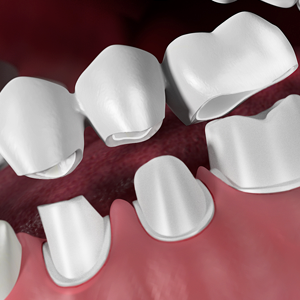
BRIDGES: Few incidents have greater impact on dental health and personal appearance than tooth loss. When one or more teeth are missing, the remaining teeth can drift out of position, which can lead to a change in the bite, the loss of additional teeth, decay and gum disease. When tooth loss occurs, your dentist may recommend the placement of a bridge. A bridge is one or more replacement teeth anchored by one or more crowns on each side.
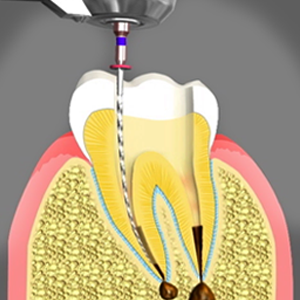
It is a field of dentistry that treats the root canal system. When decay extends to the pulp or the nerve inside the tooth, the person almost always experiences spontaneous throbbing pain. The pain increases at night and is aggravated with cold & sweet foods. The Dentist relieves the pain and pressure symptoms by treating the root canal system which houses the tooth nerve or pulp.
Treatment begins with profound anaesthesia. The tooth nerve is accessed by drilling into the tooth, the infected nerve is removed, canals are cleaned and filled with a bio-inert material.
Following a root canal treatment, the tooth is fragile due to insults from decay and mechanical instrumentation and is prone to fracture. Overtime colour changes are also observed. To protect the tooth from fracture your dentist will advise a crown. Sometimes depending upon the amount of tooth structure that is lost, a post ( a metal or a glass fibre pin ) will need to be placed for added retention of the crown. To learn more please call our office today.
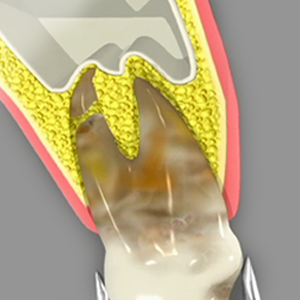
Tooth extraction is performed only when the dentist finds out that pulling it out can improve oral health of the patient. Tooth decay, crowding and risk of dental infection are some of the common reasons for tooth extraction. Dentists make a note of the medical condition of the patient before performing tooth extraction. It is a process done with the help of local anesthesia. Depending on the complexity of the extraction process a surgery may sometimes be necessary. Dentists guide patients on post operation care which helps in quick recovery from the treatment. Pain medicines and ice bags can help reduce pain and avoid swelling after the process is complete.
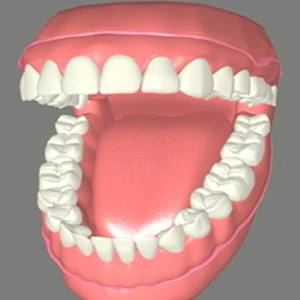
Complete dentures replace full set of teeth from upper and lower jaws of the dentition. They can aid in chewing and biting functions. Dentures can be directly fixed over gums or can be supported by implants. Complete dentures are one of the oldest methods of replacing lost teeth. There are two types of complete dentures, namely conventional and immediate dentures. With immediate dentures dentists can restore teeth in just one visit. The conventional type of dentures has a healing period of few weeks during which the gums shrink. The patient should visit the dentist the second time to get his dentures adjusted after the gums shrink.
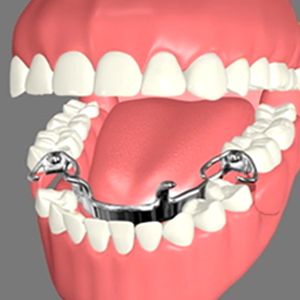
Partial dentures are used to replace few missing teeth in a row. This type of denture is preferred when there are some healthy teeth left in the dentition. Partials have clasps or other forms of connectors which are used to keep them fixed over the gums. They can be supported by natural teeth. Sometimes dental crowns may be needed to improve the fit of partial dentures with natural teeth. Partial dentures are removable and may cause some discomfort to patients initially. Over a longer term partial dentures can be a wonderful teeth restoration. It is important to take proper care of oral hygiene when living with dentures to avoid dental infection.
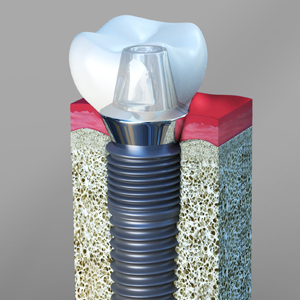
When a tooth is lost the specialized bony process that houses the tooth begins to reabsorb due to lack of stimulation. This causes a decrease in width and height of the bone in the area the tooth is lost. Neighbouring teeth and opposing teeth begin to move into the space. This causes food lodgement, subsequent decay, gum disease and abnormal forces being transmitted to teeth leading to fracture of cusps which may necessitate root canal treatment or extraction. Loss of teeth can also cause the cheek and lips to collapse giving an aged look.
The consequences of tooth loss can be prevented by replacing the lost tooth in a timely manner. Although there are several options to replace a missing tooth the number one choice for replacing lost teeth are dental implants. Implants are tiny titanium screws or posts that are surgically placed in the bone. Once integrated into bone they act like roots onto which small posts are attached which protrude through the gums. These posts provide stable anchors to the replacement teeth. Implants maintain the bone height by stimulation and prevents unnecessary trimming of adjoining teeth for bridge placement. Since implants are titanium posts there is no chance for decay on implants. Implants can service you for several years with regular professional cleaning and proper home care.
Many people who are missing a single tooth opt for a fixed bridge; but a bridge may require the cutting down of healthy, adjacent teeth that may or may not need to be restored in the future. Then there is the additional cost of possibly having to replace the bridge once, twice or more over the course of a lifetime due to decay or gum problems affecting the anchor teeth.
Another option to replace missing teeth is a removable partial denture or complete denture depending on the number of teeth missing. The chewing efficiency with a denture is reduced to more than half of that of natural teeth. The teeth that support the partial denture are weakened due to the excessive loads acting on them and eventually are lost. The denture rests on the gum causing tissue abrasion and bone loss. Removable dentures may slip or cause embarrassing clicking sounds while eating or speaking.
Studies show that within five to seven years there is a failure rate of up to 30% in teeth located next to a fixed bridge or removable partial denture.
Who is a candidate for Implants?Anyone who is missing one or several teeth is a candidate for implants. With the exception of growing children, dental implants are the solution of choice for people of all ages, even those with the following health concerns:
Existing Medical Conditions: If you can have routine dental treatment, you can generally have an implant placed. While precautions are advisable for certain conditions, patients with such chronic diseases as high blood pressure and diabetes are usually successful candidates for dental implant treatment.
Gum Disease or Problem Teeth: Almost all implants placed in patients who have lost their teeth to periodontal disease or decay has been successful.
Currently Wearing Partials or Dentures: Implants can replace removable bridges or dentures, or they can be used to stabilize and secure the denture, making it much more comfortable.
Smokers: Although smoking lowers the success rate of implants, it doesn't eliminate the possibility of getting them.
Bone Loss: Bone loss is not uncommon for people who have lost teeth or had periodontal disease. Oral and maxillofacial surgeons are trained and experienced in grafting bone to safely and permanently secure the implant.
Implant tooth replacement in children is usually deferred until their jaw growth is complete. There are, however, some instances when a dental implant may be appropriate, such as when it is part of the child's orthodontic treatment plan. Your family dentist or orthodontist can guide you in this instance.
ProcedureDental Implant placement usually takes two surgical appointments:
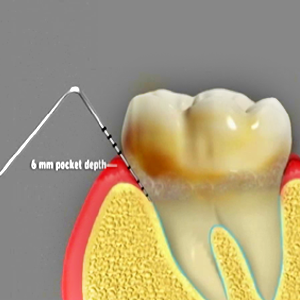
Dental tarter is a layer of deposits formed over teeth which should be removed from time to time. Normal teeth brushing and flossing may not be able to remove certain deposits. Dental prophylaxis is the medical term used for professional dental cleaning. This process is followed by dentists to prevent dental diseases. During the process plaque and other irritants which can cause harm to oral health are removed from the oral cavity. Dental prophylaxis is recommended protect the patients from dental diseases. The team also takes X-rays to check signs of tooth decay and gum infection.

Scaling and root planing also called as deep cleaning is performed to remove tarter and infectious bacteria from the surface of the teeth and roots. Dentists use special tools to remove the tarter from the gum pockets and teeth surface. This can cure and prevent gum diseases. If left untreated periodontal diseases can affect the teeth roots and cause them to loosen and fall out. The process of scaling and root planing can be done in multiple visits. This depends on the amount of tarter present over teeth. After the procedure is complete patients should follow the tips provided by dentists and visit the practice routinely to keep the periodontal disease in control.

Through the modern miracles of sedation dentistry, dentists can now safely treat anxious patients and often accomplish all dental work in one visit that may have required many more visits without it.
Dental phobia, or fear of the dentist, is not uncommon. In fact, many people avoid dental treatments altogether, as the stress and anxiety can be overwhelming. As a result, dental health deteriorates, but with sedation dentistry, offered at our practice, you can get the smile you've always wanted without the stress and fear of the dental procedures.
Who is a candidate for sedation dentistry?Nearly all patients are candidates for sedation dentistry. But sedation dentistry can help patients who have....
If you are one of those patients who hate needles, shots and the noises, smells and taste associated with dental care, call our office for a consultation with our doctor and see how you can be benefited. Don't let anxiety and fears come in the way of your dental care!
How does Oral Sedation work?For dental treatment under oral sedation, you will take a small sedative pill an hour before you come to the office. This will help you feel relaxed and sleepy and by the time you arrive, you will be very drowsy. It is necessary to have a responsible adult accompany you to the office. During your dental treatment, a trained assistant will be with you monitoring vital signs. Our doctor and our experienced team will perform all necessary dental work and though you are in a deeply relaxed state, you will be responsive to any questions or requests. When the procedures are complete, you will be gently awakened and will have no memory of your treatment.